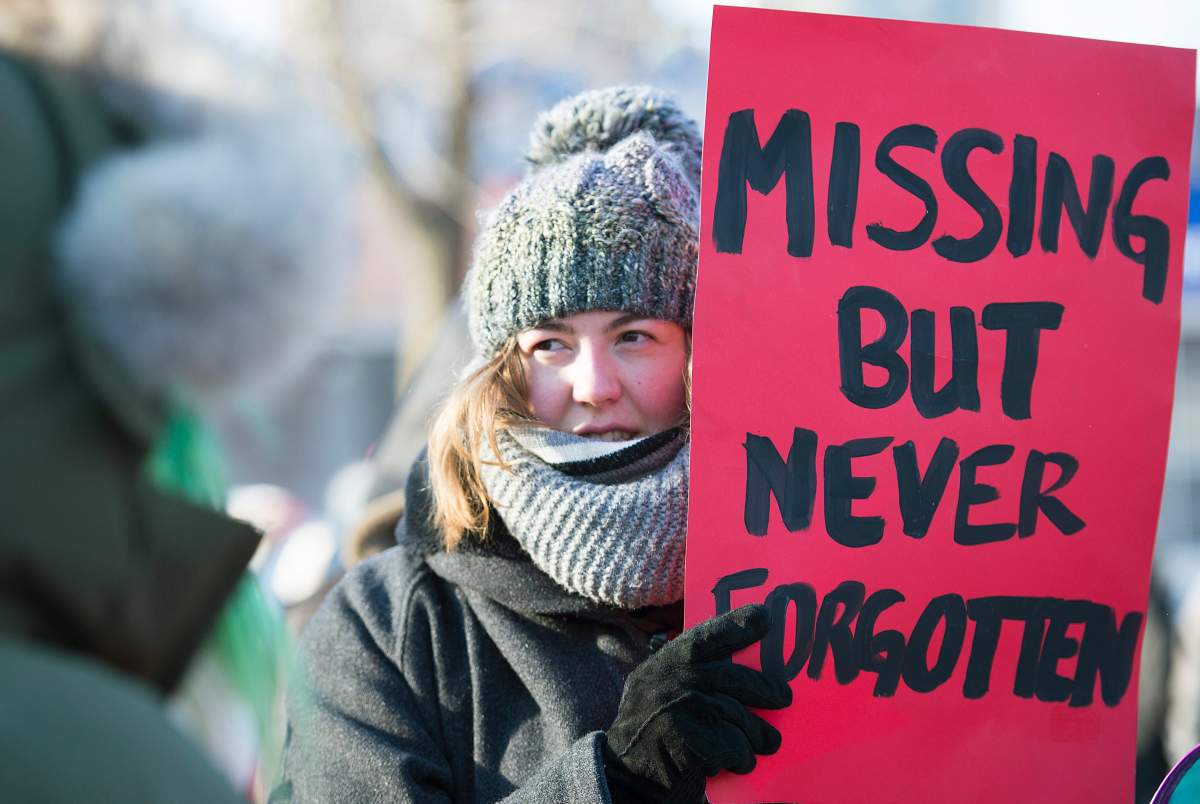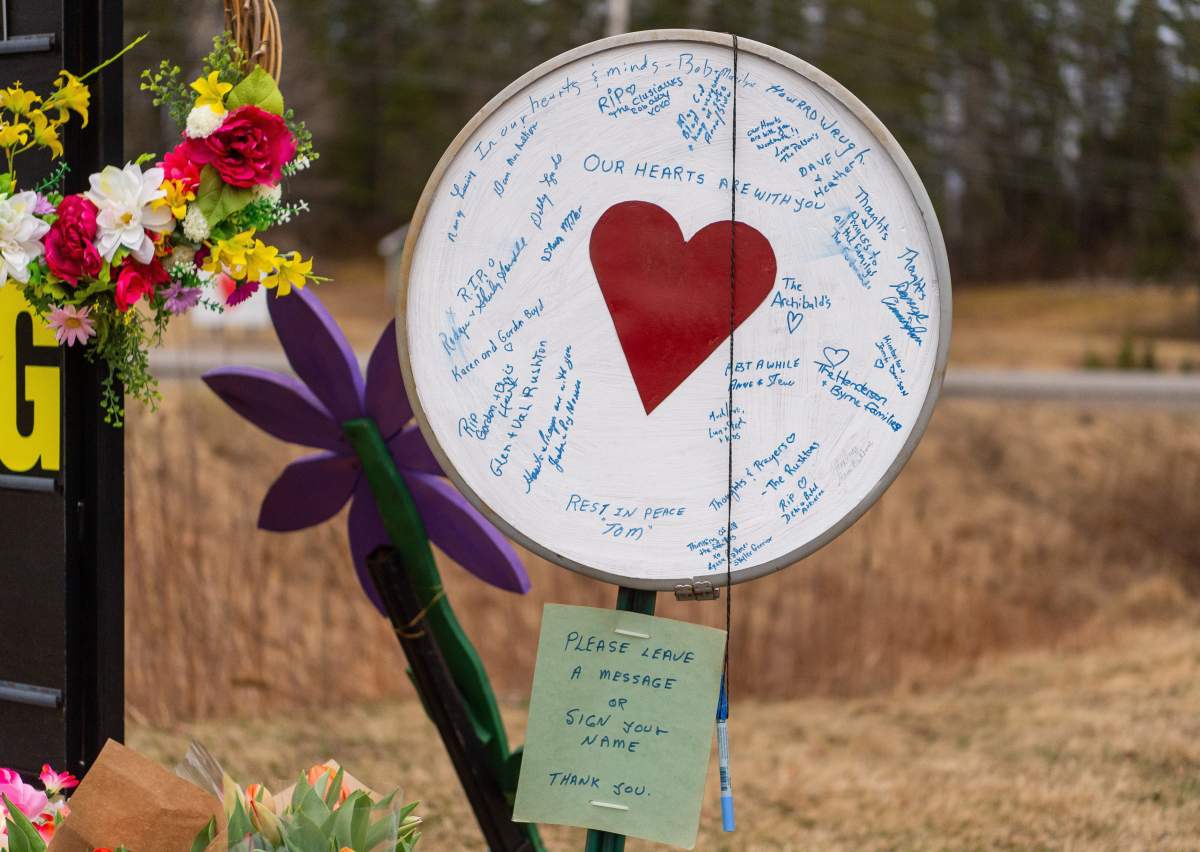What we know of the Nova Scotia shooting so far is largely from the RCMP’s recounting: a woman was assaulted by her partner and tied up. She managed to escape and hide in the woods of Portapique, a community of about 100 people 40 kilometres west of Truro, N.S. Her partner then went on to perpetrate the worst mass murder in modern Canadian history, killing 13 women and nine men.

But nobody was with her as she hid in the dark — injured and more than likely terrified, the temperature hovering near zero. She emerged at sunup and dialled 911.
We don’t know what she was thinking, nor are we privy to what she heard or saw from her hiding place as her partner went on to kill 13 people in seven separate locations in the town where they had lived together before he drove west and kept killing.
We do know, however, the details that replicate in case after case of gender-based violence.
Domestic violence is a crime that amounts to one in every four police-reported violent crimes. It disproportionately affects women, killing one woman every six or so days. It is one of the biggest warning signs for mass murders, yet more than two-thirds of spousal violence incidents do not get reported to the cops.
Running into the woods rather than to a neighbour or friend — if there was one to be safely found — is “a telling detail,” says Betty Jo Barrett, a women’s and gender studies professor at the University of Windsor.
“She didn’t run to a neighbour’s house; she didn’t run to people.”
***
Imagine the Canadian justice system is a boxing ring where the victim and (alleged) perpetrator square off. Now add the heightened emotion of a domestic violence case, where both victim and (alleged) perpetrator feel they are being unfairly blamed.
“There hasn’t been much room in between,” says Nancy Ross, an assistant professor at Dalhousie University, whose work explores feminist research and justice responses to domestic violence.
If the goal is to address the behaviours underlying acts of mass violence and the ways in which people are socialized, it’s not very helpful to pit person against person and watch their emotions run hot. But it also isn’t easy to hit pause and say, Hey, maybe this terrible, awful thing has deep roots worth exploring.
“Our society is kind of steeped in violence,” Ross says, and what’s needed is space to talk about this that doesn’t involve boxing gloves and a singular focus on one man’s horrific actions.
“The difficulty is the first step,” she says. “Taking the lid off this, acknowledging how pervasive it is.”
Right now, the lid is on.
“We’re in a society where we still blame women when they experience violence,” says Kharoll-Ann Souffrant, a PhD student in social work at the University of Ottawa who’s worked with survivors of domestic violence and sexual assault.
“It’s a catch-22: when women stay in violent relationships, they’re looked down upon, and if they leave and the perpetrator does harm to other people, they’re also blamed.”
Watch: How Natalia Jimenez survived an attempted murder

Apparently, not even the woman who survived in the woods is blameless. Her friend set up a GoFundMe page to support her recovery but told CTV News there was backlash, that the gunman’s partner — a domestic violence survivor — was being blamed. The page has since been taken down.

Get breaking National news
In silence, Ross says, domestic violence slips out of sight and blooms. Easy labels are then slapped on killers, Souffrant says. In headlines, they become “monsters… crazy or mentally ill… something that doesn’t force us as a society to question why this keeps happening at such a high rate.”
***
Public Safety Minister Bill Blair told Global News earlier this month that he intended to expand the scope of a proposed “red flag” law to include family members, victims and other people in the community.
The idea of the law is to allow health-care providers to breach confidentiality in order to report a person they feel is potentially dangerous, which could pave the way to restricting their access to firearms, including any they might already have in their possession. More than a dozen states in the U.S. have some variation of a “red flag” law.
But how much would that particular law change accomplish?
Only 11 per cent of domestic violence incidents against women include weapons (22 per cent when men are the victims), per figures gathered by Statistics Canada in 2011. Men tend to use sexual violence and criminal harassment more against women, the agency reported.
How many people would actually recognize criminal harassment — things like following a person or their friends around, trying to communicate with them non-stop, threatening them or their family or popping up to watch their home or place of work — as a red flag and feel comfortable reporting it?
Watch: What is violence against women?

One of the gunman’s neighbours, Nancy Hudson, told The Canadian Press that while she found him “very jovial,” she also noted a few “underlying issues that I think he had with his relationship.” The friend who set up and later took down the GoFundMe for the gunman’s partner made it clear the attack on April 18 was not the first time her friend had been abused by him.
A former neighbour says she’s been aware of domestic violence issues involving the gunman dating back to the early 2000s, when his partner ran to her house and said the gunman “was beating on her and she had to get away.”
“She was afraid,” said Brenda Forbes, but didn’t want to go to police.

Forbes did call the cops in 2013 after she heard reports the gunman had strangled his partner.
“I told them what happened, and I said he has a bunch of illegal weapons and I know because he showed them to us.”
Although the police interviewed her, Forbes was upset by their lack of firm action.
An RCMP spokesperson said the force has “not found a record of this complaint being filed to the RCMP.”
“As a society, so much of the domestic violence prevention that we do is focused on physical abuse,” Barrett says. “But we know that most abusers are savvy enough to know that if you hit someone in public or if you’re physically violent, that’s an unambiguous red flag.”
Most people who abuse women don’t get caught, she says.
“We know that what those people do really well that helps them to avoid detection is they get really good at exerting power and control in these socially ambiguous ways.”
In other words, Barrett says, Hudson, the gunman’s neighbour, might mention “underlying issues” because she recognized that what she saw — however ambiguous — made her feel uncomfortable.
“Those are huge, huge red flags, but we are not as adept as a society at understanding the danger of those signs.”
***
Non-profits are Band-Aids, says Nazanin Moghadami, a feminist and registered clinical counsellor in Vancouver. She supports people who don’t feel safe going to the cops or who are short on money or time or lack safe places to shelter or all of the above. Red flags coat their lives, soak into their skin.
“The system isn’t designed to absorb and meaningfully analyze those red flags, so they just dismiss them,” Moghadami says.
“Police dismiss them, the court dismisses them; women are repeatedly told not to report domestic violence, for example, in child custody cases because it undermines their credibility.”
There have been many, many reports looking at that particular issue in Canada. One, from West Coast LEAF, which works to end gender-based discrimination, found that in family court cases where women spoke of being abused by former partners, the expert tasked with assessing their parenting skills for the courts sometimes used those allegations to label the woman “hysterical” or “vindictive.”
Watch: Why we remember the École Polytechnique massacre — 30 years later

“Generally speaking, women have been bringing up these red flags repeatedly, numerous times, over and over and over and over again,” Moghadami says.
“They’re not missed, they’re actually dismissed. They’re actively being denied.”
In this world, where 70 per cent of domestic violence cases in Canada do not get reported to police for a variety of reasons that include fear of the perpetrator, general lack of trust in police and concerns around the training and varying ways in which different cops handle such cases, neighbours can make a world of difference — if we engage them.
Barrett wrote as much in a joint piece with Amy Peirone and Chi Ho Cheung for the Journal of Family Violence in 2019.
“Survivors will be less likely to seek help from their friends and neighbours if they do not feel a sense of belonging in their social context,” their article says.
But when they do? It brings the community together, makes it easier to offer support for people who might not identify openly as a survivor of violence and helps build ongoing support outside of traditional service hours.
Sometimes, after Barrett has taught her students big, complex things about domestic violence, they come to her asking for an action item that’s a little smaller, a little quicker to do.
Talk to your neighbours, Barrett says. Say “hi.”
“So many of us don’t know our neighbours’ names,” she says.
“One of the most important things people can do that takes very little time and very little energy is just getting to know our neighbours again.”
In fall 2019, as we approached the 30th anniversary of the École Polytechnique massacre, Global News took an in-depth look at the ways in which violence against women has and hasn’t improved in the decades since.
You can find the full project here.
If you or someone you know is experiencing gender-based violence, these resources can help.










Comments